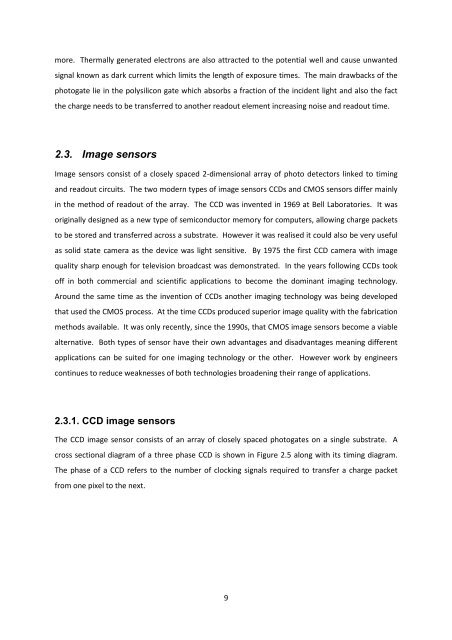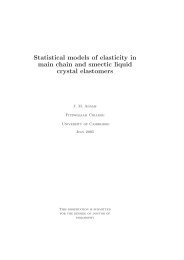Dissertation - FTP Directory Listing - University of Surrey
Dissertation - FTP Directory Listing - University of Surrey
Dissertation - FTP Directory Listing - University of Surrey
You also want an ePaper? Increase the reach of your titles
YUMPU automatically turns print PDFs into web optimized ePapers that Google loves.
more. Thermally generated electrons are also attracted to the potential well and cause unwantedsignal known as dark current which limits the length <strong>of</strong> exposure times. The main drawbacks <strong>of</strong> thephotogate lie in the polysilicon gate which absorbs a fraction <strong>of</strong> the incident light and also the factthe charge needs to be transferred to another readout element increasing noise and readout time.2.3. Image sensorsImage sensors consist <strong>of</strong> a closely spaced 2-dimensional array <strong>of</strong> photo detectors linked to timingand readout circuits. The two modern types <strong>of</strong> image sensors CCDs and CMOS sensors differ mainlyin the method <strong>of</strong> readout <strong>of</strong> the array. The CCD was invented in 1969 at Bell Laboratories. It wasoriginally designed as a new type <strong>of</strong> semiconductor memory for computers, allowing charge packetsto be stored and transferred across a substrate. However it was realised it could also be very usefulas solid state camera as the device was light sensitive. By 1975 the first CCD camera with imagequality sharp enough for television broadcast was demonstrated. In the years following CCDs took<strong>of</strong>f in both commercial and scientific applications to become the dominant imaging technology.Around the same time as the invention <strong>of</strong> CCDs another imaging technology was being developedthat used the CMOS process. At the time CCDs produced superior image quality with the fabricationmethods available. It was only recently, since the 1990s, that CMOS image sensors become a viablealternative. Both types <strong>of</strong> sensor have their own advantages and disadvantages meaning differentapplications can be suited for one imaging technology or the other. However work by engineerscontinues to reduce weaknesses <strong>of</strong> both technologies broadening their range <strong>of</strong> applications.2.3.1. CCD image sensorsThe CCD image sensor consists <strong>of</strong> an array <strong>of</strong> closely spaced photogates on a single substrate. Across sectional diagram <strong>of</strong> a three phase CCD is shown in Figure 2.5 along with its timing diagram.The phase <strong>of</strong> a CCD refers to the number <strong>of</strong> clocking signals required to transfer a charge packetfrom one pixel to the next.9
















